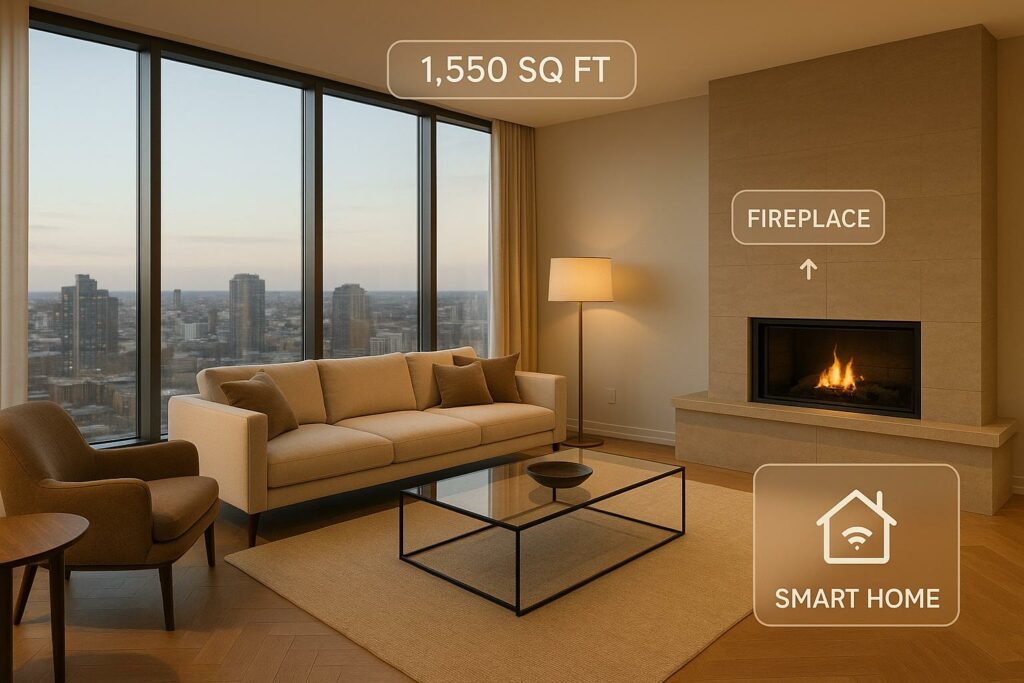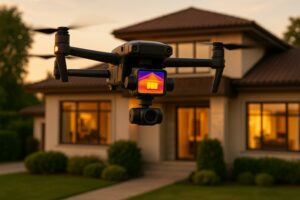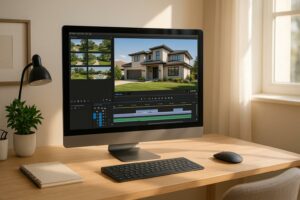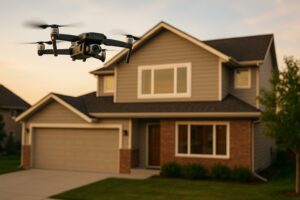AR is transforming real estate marketing. It helps buyers visualize properties with virtual staging, remote tours, and interactive 3D models – cutting staging costs by up to 97% and boosting engagement by 70%. This guide explains how AR improves property marketing, key UX design principles, tools for implementation, and metrics to measure success.
Key Takeaways:
- Why AR Matters: AR enhances property tours with immersive visuals, making it easier for buyers to imagine spaces.
- Benefits: Faster sales (31% quicker), more inquiries (up to 94% increase), and reduced costs.
- Design Tips: Use realistic staging, simple gestures, and accessible features.
- Tools: Platforms like ARKit, ARCore, and HomeJab media services.
- Future Trends: AI personalization, wearable AR devices, and blockchain for secure transactions.
| Feature | AR Marketing | Traditional Marketing |
|---|---|---|
| Engagement | Interactive and dynamic | Passive viewing |
| Visualization | 3D models, virtual staging | 2D images, basic floor plans |
| Accessibility | Remote tours, global reach | Limited to in-person visits |
| Cost Efficiency | Lower staging costs | Higher staging costs |
Ready to revolutionize your real estate strategy? Dive in to learn how AR can help you sell properties faster and smarter.
Why UX Designers Need To Learn AR (Augmented Reality UX)
How to Design User-Friendly AR Experiences for Real Estate
To make AR a powerful tool in real estate, the design must focus on ease of use. Crafting AR experiences that truly resonate with potential buyers isn’t just about showcasing advanced tech – it’s about creating interactions that feel seamless and intuitive. The best AR property tours allow users to explore homes effortlessly, without struggling to navigate the interface.
Core UX Principles for Real Estate AR
For AR to shine in real estate, it’s all about thoughtful integration and usability. Here are some key principles:
- Realistic digital staging: Virtual elements like furniture or renovations should blend naturally into the space, with proper scaling to ensure they look authentic.
- Familiar gestures: Simple actions like pinch-to-zoom, tap-to-select, and swipe navigation make the experience easy for users to pick up.
- Consistent interactions: Whether rotating a 3D model or tweaking visual features, the interface should respond predictably. Smooth, reliable interactions build trust and keep users engaged.
- High-contrast visuals: UI elements should remain clear and visible, even under varying lighting conditions.
- Spatial awareness and depth perception: Buyers need an accurate sense of room layouts. Realistic scaling, along with shadows and lighting, helps convey the true proportions of a space.
Adding 3D Models and Interactive Features
Interactive 3D models take property listings to the next level, turning static images into dynamic tools for exploration. Detailed 3D floor plans allow buyers to get a clear view of the layout.
Another game-changer? Virtual customization tools. These features let users experiment with wall colors, furniture styles, and room configurations, helping them imagine the property as their future home.
A great example is IKEA Place. This app uses AR to show furniture at true-to-scale within a user’s space, illustrating how accurate scaling and lifelike rendering can make decisions about design and space feel more confident.
By incorporating these interactive elements, AR can create experiences that work for everyone.
Making AR Experiences Accessible to All Users
Accessibility is key to ensuring AR works for a diverse audience. Here’s how to make it happen:
- Offer multiple input methods: Include options like voice commands, gestures, and touch controls to accommodate different users.
- Guided assistance: Use visual and audio cues to help users navigate features without needing lengthy instructions. Subtle animations and clear labels can make interactions feel intuitive.
"Our job as content designers is to help people interact seamlessly with the AR or VR experience by using clear signifiers, text labels and easy-to-use instructions." – Geoffrey O’Brian, Content Designer
- Adaptive interfaces: Automatically adjust contrast and brightness to match the user’s environment.
- Pause-and-resume functionality: Allow users to pause their virtual tours and pick up where they left off, making the experience stress-free.
Finally, testing is essential. Running usability tests with diverse groups and using tools like NASA’s Task Load Index (TLX) can help spot and fix issues before they reach potential buyers.
The ultimate goal? Create AR experiences that are so natural and effortless that users can focus entirely on the property, not the technology.
How to Implement AR in Real Estate Marketing
Bringing augmented reality (AR) into real estate marketing takes careful planning and the right resources. To successfully launch AR, you need three key elements: the right development tools, high-quality media assets, and smooth functionality across all devices. These components ensure AR integration feels effortless and effective.
Selecting the Right Tools and Platforms
Choosing the right tools is a crucial first step. Platforms like ARKit, ARCore, Unity with AR Foundation, or Unreal Engine are ideal for creating high-performance AR applications capable of handling complex 3D data. These tools help manage large 3D models, high-resolution textures, and interactive features. When implemented well, AR can lead to impressive results – some agencies have seen conversion rates improve by up to 40% and staging costs drop by 97%.
To deploy AR effectively, start by defining specific features you want to include, such as virtual staging, interactive floor plans, or renovation previews. Next, identify hardware requirements and set up clear data management protocols. With an estimated 1.4 million real estate agents expected to use VR technology by 2025, getting these steps right is more important than ever.
Using HomeJab Media for AR Experiences
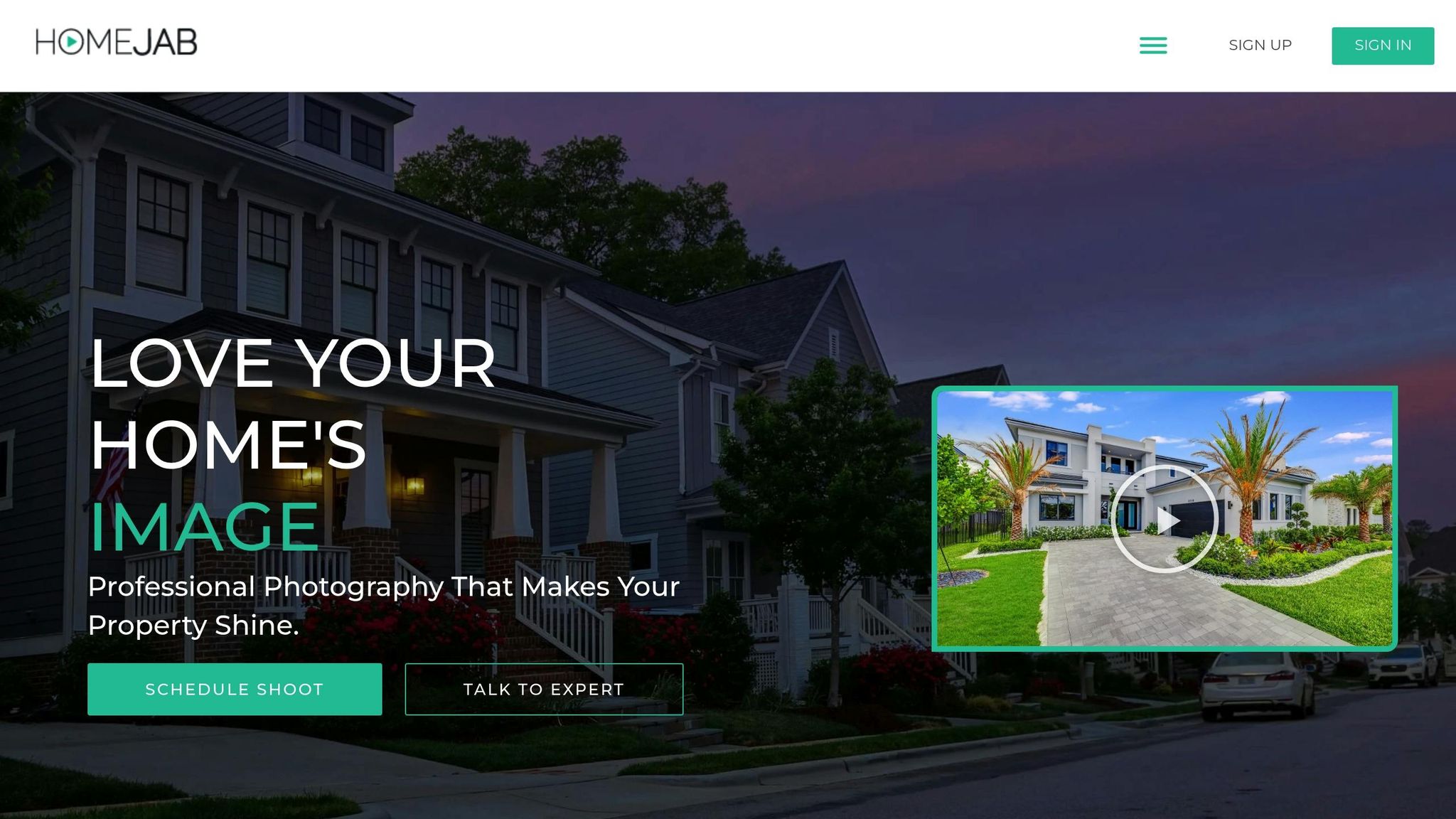
High-quality media assets are essential for creating immersive AR experiences. HomeJab provides HDR photography, detailed 3D virtual tours, and virtual staging services that serve as the backbone for AR applications. Their media ensures accurate lighting, realistic spatial mapping, and customizable designs.
HDR photography captures a property’s full range of light and shadow, offering the detailed visuals needed for realistic AR overlays. Meanwhile, 3D virtual tours provide critical spatial data, enabling precise placement of virtual furniture, accurate scaling, and seamless interaction with a property’s layout.
Combining AR with HomeJab’s media services addresses a key challenge in real estate marketing: helping buyers visualize themselves in a space. By overlaying digital elements onto high-quality base media, prospective buyers gain a clearer understanding of a property’s potential.
HomeJab also offers speed and accessibility, with a 24-hour turnaround time and nationwide service. Pricing starts at $175 for standard photo packages and goes up to $869 for comprehensive 3D virtual tours. This investment in quality media can significantly enhance AR-driven marketing strategies.
Making AR Work Across Different Devices
After selecting tools and securing media assets, the next challenge is ensuring your AR application works seamlessly across various devices. Compatibility is critical – your AR experience must perform well on smartphones, tablets, and even AR headsets, each with unique capabilities.
To adapt to different hardware, consider alternative tracking methods and adaptive quality settings. For older smartphones, simplify 3D models by reducing polygon counts and texture resolutions. For high-end devices, enable advanced lighting effects and detailed textures to showcase properties in their best light.
User interface (UI) design also plays a big role in creating a consistent experience. Ensure UI elements scale properly across screen sizes, whether on a 6-inch smartphone or a 12-inch tablet. Focus on universal interactions like pinch-to-zoom, one-tap selections, and swipe navigation.
Testing across devices is non-negotiable. For example, ARCore’s environmental tracking may behave differently than ARKit’s in low-light settings, and Android’s camera permissions differ from iOS privacy prompts. Identifying and resolving these platform-specific issues ensures a smooth user experience.
The stakes are high – 61% of shoppers say they’re more likely to buy from retailers offering AR experiences. That’s why it’s essential to create AR applications that work flawlessly, allowing users to focus on the property rather than the technology. By optimizing performance across devices, AR can revolutionize how properties are marketed and sold, unlocking new opportunities for real estate professionals.
How to Measure AR UX Success in Real Estate
Once you’ve launched your AR experience, it’s time to measure how well it’s working. This step is crucial for fine-tuning performance and proving the return on investment (ROI). Success in AR real estate marketing isn’t just about how many people view your content – it’s about tracking specific metrics that show how users engage with your virtual experiences and whether those interactions lead to tangible results. Let’s dive into the key metrics that matter.
Tracking User Engagement and Satisfaction
Understanding how users interact with your AR property tours can reveal what’s working and what could use improvement. Properties featuring AR tours can increase user engagement by as much as 30% compared to traditional methods.
- Customer Engagement Rate: This metric measures the percentage of users who actively interact with AR features during virtual tours.
- Virtual Tour Completion Rate: Tracks how many users finish the entire AR experience. A completion rate above 70% is often a strong indicator of success.
- Technology Uptime: Ensures your AR platform is operational when users want to explore. While many platforms aim for 99.9% uptime, a 99.5% rate is generally acceptable for real estate applications.
- Customer Satisfaction Score: Captures user feedback on the quality of the AR experience. High-performing AR tools typically achieve satisfaction scores between 80% and 90%.
| Metric | Calculation | Benchmark |
|---|---|---|
| Customer Engagement Rate | (Users interacting with AR / Total users) × 100 | 30%+ improvement over traditional methods |
| Virtual Tour Completion Rate | (Completed tours / Initiated tours) × 100 | Above 70% |
| Technology Uptime | (Operational hours / Scheduled hours) × 100 | 99.5%+ for real estate |
| Customer Satisfaction Score | (Positive ratings / Total responses) × 100 | 80-90% |
To improve these metrics, you can segment users based on how they engage, test interactive features like hotspots, adjust tour lengths to reduce drop-offs, and schedule system updates during low-traffic times to minimize disruptions.
Measuring Conversion Rates and ROI
While engagement metrics are vital, conversion rates and ROI provide a clearer picture of your AR strategy’s financial impact.
- Conversion Rate: This measures the percentage of users who take meaningful actions – like scheduling a viewing or submitting an inquiry – after completing a virtual tour. In real estate, AR-powered conversion rates often range from 8% to 15%, with top-performing campaigns reaching as high as 25%. For example, listings with 3D tours generate 403% more inquiries, and properties with virtual tours spend 42% less time on the market. Properties enhanced with AR also convert leads at a rate around 15% higher than those without AR features.
- Return on Investment (ROI): This metric evaluates the financial value generated compared to the cost of implementing AR. On average, real estate agencies using AR report a return of $4.50 for every dollar invested. They also see 20–30% more property showings and close deals 15–25% faster. Beyond the numbers, AR provides qualitative benefits – 89% of buyers report feeling more confident about their purchase decisions when AR tools are involved.
To maximize both conversion rates and ROI, use insights from user engagement metrics and satisfaction surveys to fine-tune your approach. Set clear AR objectives that align with your broader business goals, and integrate key performance indicators (KPIs) across engagement, satisfaction, and operational efficiency into your ROI calculations. Regular monitoring, real-time analytics, and customized evaluation frameworks that consider both quantitative data and qualitative feedback are critical for staying ahead of trends and maximizing impact.
sbb-itb-82c5f45
Future Trends in AR for Real Estate
The world of augmented reality (AR) in real estate is evolving at a breakneck pace, introducing new ways to create immersive, tailored, and secure property experiences. These advancements are reshaping how buyers, sellers, and agents interact with properties.
AI-Powered Personalization in AR
Artificial intelligence is revolutionizing AR tours by tailoring them to individual preferences. Using AI, platforms can analyze user behavior, past interactions, and interests to highlight the most relevant aspects of a property. This level of personalization is already making waves in the industry.
For instance, Compass incorporated AI-driven recommendations and property features into its search tools, resulting in a 153% increase in homepage click-through rates and a 107% rise in user engagement. AI-powered virtual staging is another game-changer, allowing potential tenants to visualize spaces in their preferred style. This aligns with a key insight: 81% of real estate agents say staging helps buyers picture a property as their future home.
E-commerce is also stepping into the mix. During AR tours, tenants can virtually furnish spaces, making it easier to plan a move. Additionally, AI enhances interactivity by providing real-time answers to questions during virtual tours, creating a more engaging experience.
This fusion of AI and AR is just the beginning, setting the stage for even more advancements in personalized property interactions.
Wearable AR Devices for Property Tours
Wearable AR devices, like smart glasses, are reshaping property tours by offering hands-free, immersive experiences. These tools are becoming indispensable for real estate professionals, offering a fresh way to showcase properties. Agents using AR for marketing have reported conversion rate increases of up to 40% and a 97% reduction in staging costs.
Smart glasses equipped with AR capabilities can overlay virtual elements onto real-world views, enabling buyers to explore digital twins of properties without needing to travel extensively. These devices also enhance accessibility by offering features like real-time captions during tours. They even integrate with smart home systems, allowing for hands-free property management.
Remote property tours are also seeing major improvements. Real estate agents can guide clients through properties via live video conferencing, creating a shared virtual experience that feels almost as if the client is physically present.
"AR has been here for a while. Now is the time for real estate professionals to give their clients new ways to see more possibilities in existing properties and develop even better ways to market, show and sell them." – Dan Weisman, Director of Innovation Strategy, National Association of REALTORS®
Blockchain Integration for AR Property Data
As AR technology becomes more advanced, ensuring the accuracy and security of property data is critical. Blockchain is emerging as a key tool to address these challenges, offering unchangeable records of ownership and transactions. This transparency is vital, especially when you consider that 1 in 120 mortgage applications in 2021 contained fraud. With the global real estate market valued at over $11.4 trillion, the stakes are high.
One promising application of blockchain is smart contracts, which can automate processes like title searches and escrow services, cutting out intermediaries and reducing costs. Tokenization is another innovation, making real estate investments more accessible by enabling fractional ownership. Blockchain-based digital identities further enhance security, giving users control over their personal data while accessing AR and VR environments.
Real-world examples of blockchain in action are already here. PixelPlex’s DocFlow, for example, is a blockchain-powered app that digitizes and secures real estate documents on an immutable ledger. This prevents unauthorized changes or transfers, streamlining the entire document management process. By 2025, over 60% of real estate transactions are expected to involve some form of digital automation, making blockchain integration essential for staying competitive.
Conclusion: How AR Changes Real Estate
Throughout this guide, we’ve seen how augmented reality (AR) is reshaping property marketing from concept to closing. By revolutionizing how buyers engage with properties, AR is delivering measurable results: real estate agents using AR report higher conversion rates while cutting staging costs. With 70% of professionals already incorporating AR into their strategies, it’s clear this is no passing trend – it’s quickly becoming the industry standard.
AR allows buyers to virtually explore properties, tailor their viewing experiences, and make more confident decisions. Virtual tours, for instance, generate 49% more qualified leads, with 67% of homebuyers expressing strong satisfaction with these immersive tools. This technology bridges the gap between physical constraints and buyer expectations, offering possibilities that traditional approaches simply can’t match.
"AR has been here for a while. Now is the time for real estate professionals to give their clients new ways to see more possibilities in existing properties and develop even better ways to market, show and sell them." – Dan Weisman, Director of Innovation Strategy at the National Association of REALTORS®
To fully unlock AR’s potential, integrating high-quality visual media is essential. This shift from digital tools to visually rich experiences underscores the importance of professional content. HomeJab’s suite of services – ranging from HDR photography and 3D virtual tours to aerial photography and virtual staging – provides the foundation AR platforms need to create engaging buyer experiences. With a 24-hour turnaround and nationwide availability, HomeJab positions agents at the cutting edge of real estate marketing.
As AR’s market influence continues to grow, early adopters will shape the future of property marketing. Those who embrace AR now, supported by top-tier media services like HomeJab, will lead the charge in transforming the industry. The real question is: will you take the lead in driving this change or be left watching from the sidelines?
Start crafting your AR strategy today by investing in premium visual content, selecting intuitive platforms, and equipping your team with the skills they need. Buyers are increasingly seeking immersive, personalized property experiences, and AR is the key to meeting – and exceeding – those expectations.
FAQs
How does augmented reality (AR) enhance the home-buying experience in real estate?
Augmented Reality in Home Buying
Augmented Reality (AR) is changing the way people shop for homes by delivering virtual and interactive property tours. Instead of relying on static photos or videos, AR allows buyers to step into a home digitally. They can explore spaces as if they were physically there, experiment with furniture placement, try out different color palettes, or even envision potential renovations – all in real-time. It’s a whole new level of engagement that feels more personal and tailored.
On top of that, AR simplifies the home-buying process with features like interactive floor plans and instant access to detailed property information. These tools empower buyers to make faster, well-informed decisions. For real estate agents, incorporating AR technology is a great way to grab attention and stand out in a crowded market.
What are the key UX design principles for using AR in real estate?
When creating augmented reality (AR) experiences for real estate, following a few key UX principles can make the experience both intuitive and enjoyable.
First, ensure the digital and physical worlds work together seamlessly. AR elements should feel like a natural extension of the real environment, allowing users to focus on exploring the property instead of wrestling with a clunky interface.
Next, prioritize a clean and organized interface. Avoid overcrowding the screen by displaying only the most essential information upfront. Additional details can be tucked into layers or menus, giving users the freedom to dive deeper without feeling overwhelmed.
Lastly, simplify the onboarding process. Whether it’s through a quick tutorial or an intuitive design, help users quickly grasp how to interact with AR features. This not only builds confidence but also enhances their overall experience. By prioritizing thoughtful UX design, AR can elevate property tours rather than complicate them.
How can real estate professionals evaluate the success and ROI of using AR in their marketing efforts?
Measuring the Success of AR in Real Estate Marketing
To figure out how well augmented reality (AR) is working in real estate marketing, professionals should focus on specific key performance indicators (KPIs). For instance, metrics like engagement rates from AR property showcases and conversion rates – how many virtual tour viewers become actual inquiries or buyers – can reveal a lot about AR’s effectiveness.
Another critical area to monitor is the cost per lead or customer acquisition cost (CAC). These numbers help determine if the money spent on AR tools is worth the results they’re delivering. By diving into these metrics, real estate professionals can fine-tune their strategies and aim for better profitability.

